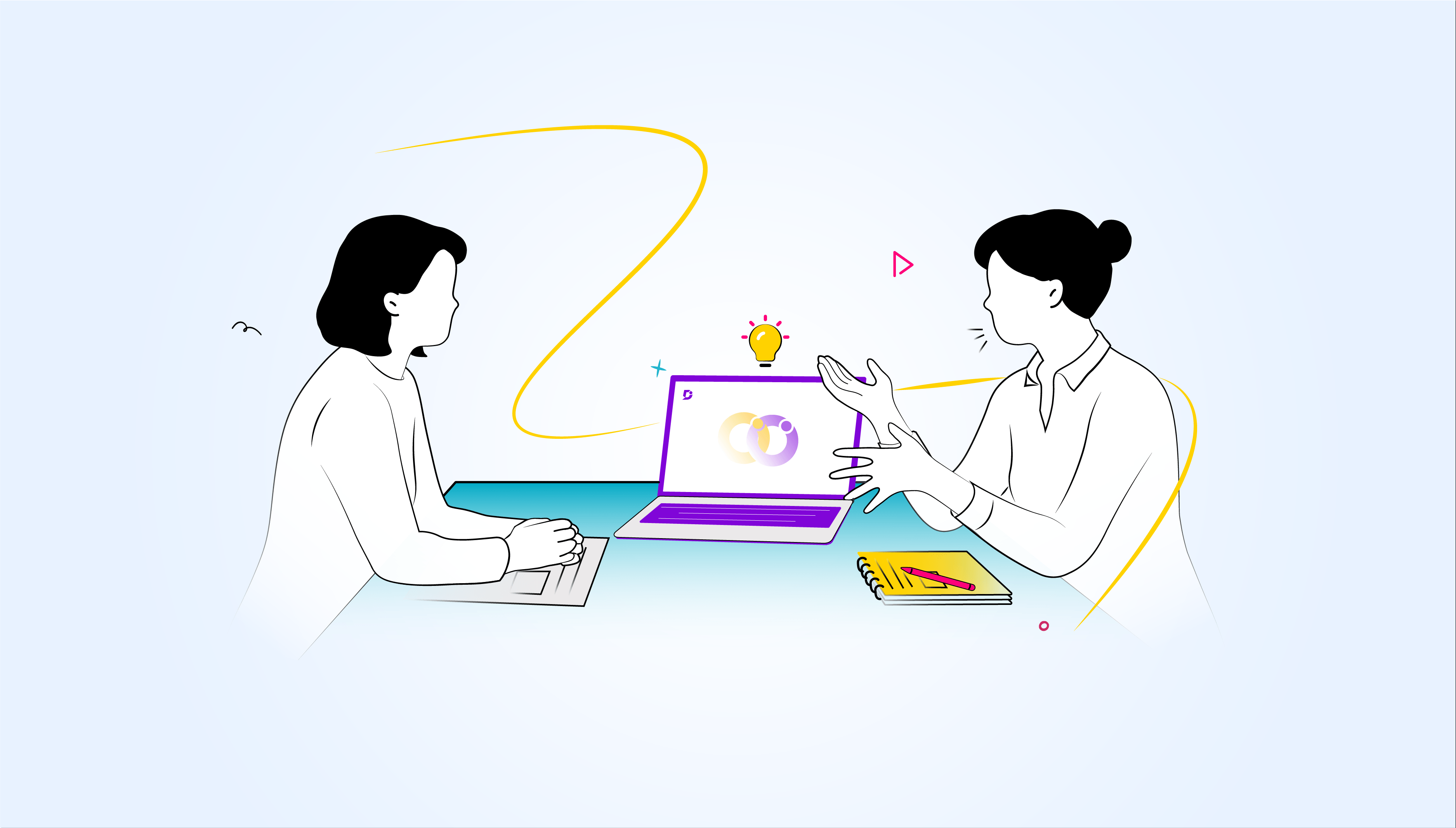Remote working has become a prevalent and often necessary mode of work for many people in the current stage, influenced significantly by the COVID-19 pandemic.Now you don’t have to compromise on time, staying up late cause you want to catch up with a team member in another timezone (well, except for meetings.)
Organizational learning (OL) and knowledge management (KM) play a huge role in making the above possible. How? The only reason you can do your job effectively without needing to wait for a team member is because of information. You have the right information to do your job without having to wait.
OL and KM provide knowledge accessibility and applicability to teams. In this article, you will understand why businesses leverage Organizational Learning in collaboration with Knowledge Management.
- Organizational Learning (OL) – This involves constantly improving your organization’s capabilities by learning. This could be through formal or informal means.
- Knowledge Management (KM) – developing, applying, and sharing knowledge through consistent research.
- Organizational learning is built upon Knowledge Management. KM involves extracting information from various relevant sources to enhance the learning process, while OL is the application of knowledge obtained using KM to boost organizational skills.
- “Competitive Advantage” – the icing organizations crave, can be achieved by effectively utilizing Knowledge Management and Organizational Learning principles.
Organizational Learning and its Significance
Organizational learning involves acquiring knowledge, skills, and insights at an organizational level.
A company is never the same after a couple of years; the market is changing, staff are evolving, and products are different. Because change is constant, you need organizational learning because it will drive the company to adapt, evolve, and remain competitive.
Knowledge Management in Organizations
Knowledge management is how organizations gather, organize, and share information with employees, customers, and business partners.
Power of Organizational Learning and Collaboration with Knowledge Management
Organizational Learning (OL) and Knowledge Management (KM) function as catalysts within a company, increasing innovation and competitive advantage.
The foundation of an organization’s success lies in collaboration and knowledge sharing. But this comes with its problems due to diverse views and opinions. However, properly implementing of OL and KM will create a system where every unique perspective is appreciated and critically evaluated, leading to well-informed decision-making.
Accelerated Innovation
Organizations need to build an internal knowledge hub that allows employees to access information, be more interactive among team members, and share each other’s knowledge while saving time for ideas. But that’s not all. They also need to promote a culture of continuous learning among leaders and employees.
The result? Accelerated innovation.
A solid knowledge management system like Document 360 and continuous learning can facilitate information sharing and speed up access to knowledge, increasing innovation.
Adaptability in a Dynamic Landscape
The business landscape has experienced many changes and is predicted to keep changing. To keep up with the tide, organizations are advised to make strategic decisions in line with industry benchmarks.
A study by Korn Ferry emphasized that 85% of leaders believe their organizations need more time to be ready for the speed of change.
This is where organizational learning and knowledge management come in. They provide the tools and mindset (collective learning and shared knowledge) needed to adapt to these dynamic business landscapes.
Holistic Problem Solving
Problems within an organization are like puzzles. They come in different shapes and sizes, each requiring a unique problem-solving approach. Often, more than one perspective is needed to crack the code; hence, a holistic problem-solving approach is needed.
If two heads are better than one, imagine what multiple heads would do; the pooling of knowledge through Organizational Learning and Knowledge Management promotes holistic problem-solving by letting employees look at a problem and develop solutions that consider multiple perspectives.
Synergy of Expertise
The principle of synergy in Systems Theory postulates that “the whole is greater than the sum of its parts.” An organization is a system, and its human resources make up an essential part. Thus, only the best output is obtained when people with different skills and knowledge come together in a team. In any organization, each person brings their own unique abilities and experiences to the table.
Organizational learning and knowledge management are all about tapping into this collective expertise. A synergy of different teams combines individual strengths to create a driving force that helps the organization succeed beyond expectations.
Employee Empowerment
The motivational theories of management highlight the importance of employee empowerment. There’s a reason why people do what they do, and there’s always a motivation behind it.
Knowledge sharing allows leaders to understand each employee’s personality and motivation. Then, they can build on that information to create an environment that empowers employees and increases productivity.
Building an environment that encourages knowledge-sharing and continuous learning empowers your employees; their work is easier, they don’t have to run through hoops to find information, and they can share ideas without fear of rejection. Everyone is happy.
Continuous Improvement
LinkedIn’s 2019 Workforce Learning Report shows that 94% of employees are likely to stay with a company that invests in their learning and development.
Creating a culture of continuous learning, which is at the heart of organizational learning and knowledge management, encourages employee improvement, which is paramount to excellence. A key aspect of this culture is the adoption of skills based learning, focusing on practical and applicable skills that directly enhance employee capabilities and align with the company’s strategic goals.
Effective Communication
Poor communication within a team will lead to misinformation and goal congruence, leading to a high employee turnover rate due to resulting misunderstandings and workplace instability. Employees who feel unheard or undervalued are more likely to seek opportunities elsewhere, threatening the going concern concept of the organization and increasing the learning curve.
Knowledge Management and Organizational Learning create means of communication for your employees, promoting cross-team collaboration and reducing silos.
Knowledge Preservation
Trade strategies, secrets, and compasses are valuable and should be preserved so that they can be passed on to others in the event of an employee leaving. This is where knowledge preservation comes in.
Knowledge preservation involves capturing, organizing, and storing critical information and experiences.
You can use the Document360 knowledge base site feature to store and manage documents. In the case of trade strategies and secrets, you can make the site private (requiring users to log in) and restrict access to a certain IP range for extra security.
Schedule a demo with one of our experts to take a deeper dive into Document360
Book A Demo
Cultivation of Leadership
Leadership is not just a position; it’s a quality that, when nurtured, can transform an organization. Effective leadership propels a company towards its vision, motivates teams, and fosters a positive work culture.
According to a report by LinkedIn, 86% of companies say developing new leaders is an urgent or important need. OL and KM provide the learning environment necessary for leadership development because through the collaborative learning it offers, talents are identified and appropriate leaders are easily appointed.
Informed Decision-Making
Organizations need information in order to make decisions that are in line with their mission and vision statements. This information is necessary to avoid misdirection and poor implementation of strategies.
Organizational learning grants an organization access to a rich knowledge repository that serves as a map for strategizing and decision-making in every stage of the organization’s life cycle.
Faster Learning Cycles
An organization has to go through the learning process for the rest of its existence, all thanks to the dynamic nature of business. However, if not properly handled, the organization can get stuck in a learning hell in which learning continues without the implementation of acquired knowledge, causing stagnation and poor functionality.
The integration of Organizational Learning (OL) and Knowledge Management (KM) shortens these learning cycles by providing tools that enable employees to learn on the job, leading to specialization, and most importantly, they get to implement their learnings on the job.
Cultural Enrichment
Culture is an organization’s DNA, defining its identity, values, and behavior. A learning and knowledge-sharing culture enriches this DNA, fostering a vibrant and engaging work environment.
TinyPulse, in their survey, states that peers are the #1 reason employees go the extra mile at work. Organizational Learning and Knowledge Management strengthen this peer-to-peer interaction, building a solid workplace relationship and culture that is hard to erase.
Innovation Beyond Boundaries
In one of our previous blogs, we discussed organizational silos and how they stifle innovation and growth.In that article, we shared so many ways to combat silos, and the main ones were continuous learning and knowledge management.
When you build a culture where people can communicate, learn, share knowledge, and ask for help, you eliminate organizational silos. When silos are off the table, innovation becomes a breeze.
Sustainable Growth
Growth in itself is not enough, but one that stands the test of time is what every organization craves. Sustainable growth is key to any organizational success, and this is why it is reflected in the mission portfolio of every organization.
The combination of organizational learning and knowledge management establishes the foundation for sustainable organizational growth. Companies that prioritize knowledge management will have a higher survival rate because they are always growing and adapting to change.
Benefits of Organizational Learning and Collaboration
Growth and innovation are just some of the many benefits you reap from incorporating continuous learning, knowledge management and collaboration in your organization. This section is going to cover some of the other benefits.
Enhanced Adaptability and Agility
Organizational learning coupled with effective knowledge management cultivates enhanced adaptability and agility. A survey by McKinsey revealed that companies that promote a culture of continuous learning are 30% more adaptable to market changes. Continuous learning allows for easy prediction and early implementation of defensive strategies in cases of threats and, in cases of opportunities, better positioning for success.
Innovation and Creativity
PwC’s Breakthrough Innovation and Growth study states that 74% of CEOs regard innovation as important to their company’s success. We already spoke about innovation in the previous section. Still, to buttress our point, when an organization makes learning and collaboration part of its culture, it grows essentially because of diversity.
Diversity in this context is not limited to race or skin color. We are also talking about skills and ideas. In an article by McKinsey titled ‘Why diversity matters,’ the author said, and we agree, “more diverse companies are better able to improve their customer orientation, employee satisfaction, and decision making, and all that leads to a virtuous cycle of increasing returns.”
To add to that, encouraging collaboration among cross-teams will lead to skyrocketed growth.
Enhanced Communication
Effective communication in the workplace leads to better understanding, thereby building a healthy work environment where success can thrive. By incorporating organizational learning to your culture, you are encouraging cross team collaboration and communication.
Cross-Functional Synergy
OL and KM promote cross-functional synergy, creating room for the harmonization of diverse skills for the achievement of a unique goal. Harvard Business Review’s post on Cross-Functional Management indicates that companies with strong cross-functional capabilities achieve higher revenue growth. This beautiful merger of talents that OL and KM provide pilots the organization to grow.
Employee Engagement and Satisfaction
Employees are the driving force of every organization, and when dissatisfied, productivity tends to decline. However, a culture of organizational learning and collaboration encourages employees to share their expertise and connect with team members, fostering a sense of engagement and job satisfaction. It provides an avenue and a safe space for employees to collaborate their ideas, boosting morale and hence enhancing satisfaction. It is a win-win situation for both the company and the staff.
Quality Improvement
Learning leads to upskilling, and this improves the value of the staff and the organization. The world has evolved from the viewpoint of quantity to quality. Therefore, every organization seeks to improve the value of their offer, hence undergoing knowledge and skills like customer problem-solving strategies, highly effective training modules, or streamlined financial calculations. This reduces repetitive tasks and boosts the quality of delivery, leading to consumer satisfaction and business productivity and profitability.
Talent Development
Organizational Learning and Collaboration help in recognizing exceptional talents and skills. Deloitte’s Leading in Learning research shows companies with a strong learning culture have 37% higher employee productivity. Most employees are unaware of the talents they possess. By investing in employee development through OL and KM, these gems are discovered and nurtured for the benefit of the organization.
Customer Satisfaction
According to a Salesforce report, 73% of customers expect companies to understand their needs. OL and KM contribute to this understanding by bringing the needs of customers to the awareness of the organization, and they use this to provide goods and services that give maximum satisfaction. Satisfied customers are more likely to remain loyal and advocate for the brand.
Schedule a demo with one of our experts to take a deeper dive into Document360
Book A Demo



Overcoming Challenges in Organizational Learning
Organizational learning comes with its challenges, and it is the duty of management to curb and eliminate these challenges. But first, let’s look at some of the challenges and see the suitable ways to deal with them.
Lack of Leadership Support
Most times, leaders in organizations inefficiently prioritize their roles, and this hinders the implementation of organizational learning. In a Gartner article titled ‘Why Leaders Succeed,’ the author Sharon George said, “for learning initiatives to be successful, most of the responsibility lies with leadership.”
When leaders’ interests do not align with that of the learning objective, there is a lack of support, and therefore, learning does not go as planned.
Resistance to Change
Rigid processes and mindsets pose as barriers to learning and accepting the new developments in the business world. Businesses and organizations should realize that the only constant factor is change and, therefore, embrace a more flexible and welcoming mode of operation.
Knowledge Silos and Communication Barriers
Project Management Institute found that employees hold 67% of knowledge and are not effectively shared. KM strategies should be adopted because they help ease the flow of information and enable easy achievement of goals.
Inadequate Learning Infrastructure
Most organizations are under-equipped in terms of learning facilities, and this poses a threat to organizational learning. The right infrastructure should be implemented to ensure employees get the best learning experience, as this would benefit everyone involved.
Lack of Time and Resources
Poor scheduling has led to poor time management in workplaces. Lack of time can also be attributed to work overload and multitasking. LinkedIn Learning found that 58% of employees prefer to learn at their own pace. It is advised that learning programs should be custom-made for each employee, alongside every necessary resource required to make their learning a success. This would make the learning process easy, fun, and less time-consuming.
Ineffective Measurement and Assessment
One of the biggest challenges with organizational learning is measurement and assessment. No one can accurately measure and assess employees to know if they’ve learned. But there are ways around it.
However, one of the biggest mistakes many organizations make with assessment is setting unrealistic expectations. To rectify that, trained project managers should be put in place to prepare realistic expectations for learning.
Also, with knowledge management software like Document360 with an analytics feature, you see how your employees interact with the content: what they read, what they like, etc.
Conclusion
As we emphasized throughout this piece, the world is changing, and organizations that can’t adapt will be left behind. The only way to ensure that your organization rises above the competition and trends is by creating a learning culture and investing in knowledge (for employees and customers).
An intuitive knowledge base software to easily add your content and integrate it with any application. Give Document360 a try!
GET STARTED








